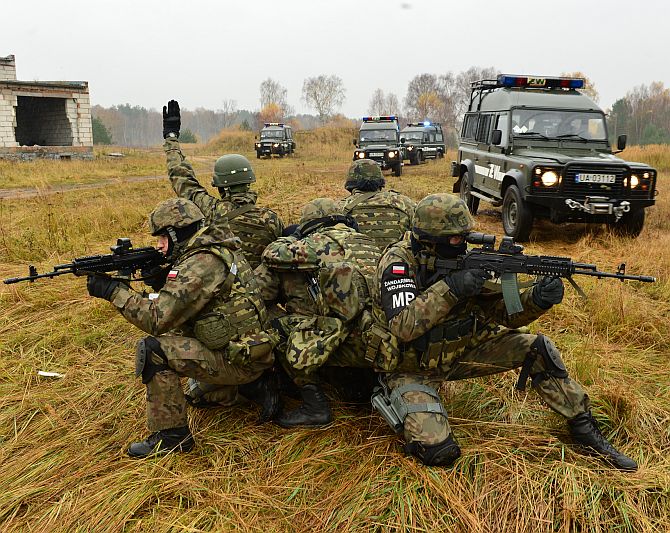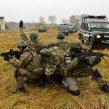
NATO Holds Article Five Exercise in the Baltic Region
Publication: Eurasia Daily Monitor Volume: 10 Issue: 203
By:

On November 2–November 9, the NATO Response Force (NRF) conducted the Steadfast Jazz 2013 troop exercise in Poland, Lithuania, Latvia and Estonia, combined with the Baltic Host logistical exercise in the latter three Baltic States. The hosting countries had been awaiting exercises of this type and scope for a long time. This year’s Steadfast Jazz was the first-ever NRF exercise in the Baltic region, and the first-ever combat exercise in this region under the Washington Treaty’s Article Five clause for common defense. Also for the first time, the logistical exercise was directly coordinated with the troop exercise.
According to the exercised scenario, Estonia is attacked by an unnamed major power from the northeast. The unnamed major power poses territorial claims and then occupies the claimed territory. The United Nations Security Council gathers, but fails to authorize action against the aggression. The North Atlantic Council (NATO’s top political authority) decides to invoke Article Five and sends the NATO Response Force to the Baltic States to roll back the aggression in Estonia. The scenario also involved dealing with cyber attacks and humanitarian collateral effects of the aggression (BNS, November 2).
Steadfast Jazz 2013 aimed to test the NRF’s readiness to deploy for the defense of the Baltic States if necessary. The exercise involved a total of some 6,000 military personnel from almost all of NATO’s member countries, as well as Sweden, Finland and Ukraine as partner countries. The overall numbers included more than 1,000 ground troops in mechanized formations, some 60 aircraft and helicopters, 15 naval surface vessels and two submarines. Poland assigned more than 1,000 troops to the exercise while Estonia, Latvia and Lithuania assigned between 200 and 300 each. France, which will command the NRF’s land component in 2014, sent more than 1,000 troops to this exercise. By contrast, the United States, the United Kingdom and Germany contributed disproportionately few troops and hardware.
The Bundeswehr’s General Hans-Lothar Domroese, Commander of the Allied Joint Force Command headquartered in Brunssum, the Netherlands, was the chief commanding officer of Steadfast Jazz 2013. The Brunssum headquarters will command the NATO Response Force in 2014. The NRF is a multinational combined force comprising land, air, naval and special forces. NATO countries and a few partner countries assign specific units to the NRF every year on a rotational basis. The overall strength in high-readiness troops (the “Immediate Response Force”) is stated as 13,000 this year (https://www.bundeswehr-journal.de/2013/gewachsene-verteidigungsgemeinschaft-uebt-fuer-die-zukunft-steadfast-jazz-2013/; https://www.nato.int/cps/en/natolive/topics_49755.htm).
Latvia’s Adazi military base outside Riga hosted the command-and-control headquarters under Gen. Domroese for the whole Steadfast Jazz 2013 exercise. In one phase of that activity, infantry brigade headquarters of Estonian, Latvian, and Lithuanian forces joined the Danish Division’s headquarters to plan operations against a hypothetical aggressor force in the area of Tallinn. The Danish Division, the largest unit of Denmark’s forces and assigned to NATO’s Northeastern Corps, has been conducting joint planning and staff exercises with the Baltic States’ brigade headquarters in recent years (BNS, November 2–9).
THE Drawsko Pomorskie training range in Poland’s northwest hosted the Steadfast Jazz 2013 tactical troop exercise, including a live-fire phase. Russian and other non-NATO observers were present by invitation. The three Baltic States’ presidents and defense ministers joined NATO’s Secretary-General Anders Fogh Rasmussen on November 6 at the Adazi Base, for a detailed briefing on the exercises. On November 7, Rasmussen, with some Baltic dignitaries as well as Poland’s state leadership, witnessed the live-fire phase at Drawsko Pomorskie (NATO HQ press releases, nato.int, November 7, 8).
Poland’s port of Gdynia hosted a multinational naval exercise of the standing NATO Mine Countermeasures Group 1, supplemented by several combat units. This naval phase of Steadfast Jazz practiced mine-hunting and clearance to ensure safe access for incoming NATO forces that, according to the scenario, were to repel an aggression (https://www.mcm.mw.mil.pl/index.php?vhost=mcm&akcja=news_ang&filter=&id=282&limes=).
Baltic Host is a multinational logistics planning exercise, hosted annually since 2009 by one of the three Baltic States on a rotational basis. It involves military staffs and civilian agencies, as part of Host Nation Support (HNS) agreements between NATO and the Baltic States. Under HNS agreements, the three states build and maintain infrastructure for receiving Allied forces in peacetime as well as in military emergencies, and ensure the movement of such forces over the territories of the three Baltic States.
This year’s Baltic Host was held for the first time simultaneously with, and as part of, the Article Five–oriented military exercise (see above). Baltic Host 2013 tested the three states’ readiness to receive Allied forces in response to a hypothetical aggression. Personnel from several NATO headquarters and staffs participated in the exercise at the Estonian defense forces’ simulation center in Tartu and other Baltic locations. Relevant government ministries, the highway, railroad, port and airport authorities, as well as police and internal security services from Estonia, Latvia and Lithuania planned logistical arrangements for receiving and moving allied units, as part of the scenario to repel an attack from the northeast (see accompanying article).




